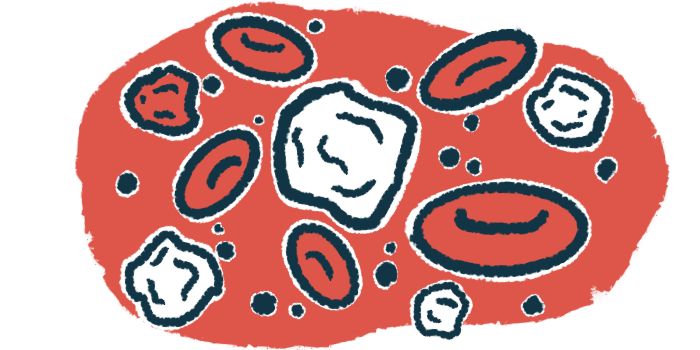New Therapeutic Target to Ease CF Lung Inflammation Discovered
Reducing monocyte activity lowered damaging immune cell totals, prevented lung damage

Researchers have discovered that monocytes, a type of white blood cell, drive persistent and sustained inflammation that leads to lung damage in people with cystic fibrosis (CF), a study reported.
The researchers showed that, in a CF mouse model, reducing monocyte activity lowered the number of tissue-damaging immune cells and prevented lung damage, suggesting it could be an effective therapeutic target for inflammation in CF.
The study,” Recruited monocytes/macrophages drive pulmonary neutrophilic inflammation and irreversible lung tissue remodeling in cystic fibrosis,” was published in Cell Reports.
In CF, inherited defects in the CFTR channel protein impair cells’ ability to regulate the flow of water and salts across membranes. As a result, the layer of mucus that usually protects the airways becomes thick and sticky, making patients more susceptible to ongoing infections.
Early on, even before infections become chronic, mucus buildup can trigger an inflammatory response, leading to lung tissue damage.
“Babies with cystic fibrosis can seem totally fine with normal respiratory function, but the reality is that the disease is already having an effect,” said Emanuela Bruscia, PhD, study senior author at Yale School of Medicine, in a university news release. “Mucus is already accumulating, and there are areas in the lung with inflammation. And inflammation, if not controlled, is bad for any type of tissue.”
With the recent approval of CFTR modulator therapies, which correct CFTR defects, CF lung disease’s impact has diminished while lung function and survival have improved. Long-term studies suggest these therapies don’t address excess lung inflammation over time, however. Therefore, new therapeutics are needed to ease inflammation and preserve lung function.
To understand what drives CF lung inflammation, Bruscia’s team examined lung tissue from patients with advanced CF who’d had a lung transplant. Compared to healthy donor samples, CF samples had high levels of monocytes carrying the CCR2 receptor, especially where there was tissue damage.
Monocytes are a type of white blood cell released into the bloodstream from bone marrow and, when signaled via the CCR2 receptor, migrate into tissues to fight infection. There, they can release signaling molecules to attract other immune cells and/or transform into macrophages — a type of white blood cell that can destroy invading microbes, but is known to contribute to CF-related inflammation.
Exploring monocyte activity’s role in inflammation
To investigate the role of CCR2 monocytes in lung inflammation, the researchers repeatedly exposed the lungs of mice to the chemical LPS, which triggered irreversible lung damage and functional decline, similar to CF patients.
“The question was how those cells participate in the disease,” Bruscia said.
After exposure to LPS, CF mice had significantly more CCR2-monocytes than non-CF mice as well as more immune cells derived from monocytes, including macrophages.
Exposed CF mice had lung inflammation caused by an influx of tissue-damaging neutrophils, the most abundant type of white blood cell, promoted and sustained by CCR2-monocyte signaling. Also, CCR2-derived lung monocytes and macrophages drove altered signaling of TGF-beta, a pro-inflammatory, pro-fibrotic (scarring) signaling protein.
Six weeks after LPS exposure, the number of immune cells in non-CF mice returned to normal levels. In contrast, CF mice maintained significantly increased numbers of lung immune cells, including CCR2-monocytes, macrophages, and neutrophils, “consistent with impaired resolution of the inflammatory response,” the researchers wrote.
After LPS was withdrawn, CCR2-monocytes/macrophages sustained an immune response gene activity signature that perpetuated immune cells being recruited to the lungs. This was linked primarily to a lack of CFTR function in CCR2-monocytes rather than the CF lung environment, data suggested.
“Pro-inflammatory monocytes are part of the normal immune response, but once they arrive and do their job, they should be instructed to leave and be silent,” Bruscia added. “But in cystic fibrosis, they arrive, they are super inflammatory, and then they are in an environment in which they can’t leave and be silent, so instead, they keep producing these pro-inflammatory mediators.”
Enhanced CCR2-mediated monocyte recruitment also drove tissue damage in the lungs. After the LPS withdrawal, non-CF mice were able to repair the damage, whereas CF lungs’ repair capabilities were impaired.
Pro-inflammatory monocytes are part of the normal immune response, but once they arrive and do their job, they should be instructed to leave and be silent. But in cystic fibrosis, they arrive, they are super inflammatory, and then they are in an environment in which they can’t leave and be silent, so instead, they keep producing these pro-inflammatory mediators.
In mice bred to lack CCR2, lung tissue was protected from LPS damage, suggesting a decrease in CCR2-monocyte recruitment may re-establish and balance immune cell populations in CF lungs and ease progressive lung damage, the researchers noted.
Building on these findings, the team treated mice with a small molecule that blocks the CCR2 receptor, starting three days before, and maintained throughout LPS exposure. The CCR2 blockade controlled the recruitment of monocytes, macrophages, and neutrophils to levels comparable to non-CF mice after the LPS exposure.
“Importantly, the CCR2 inhibitor didn’t block all of the monocytes. It just brought the numbers down closer to healthy levels,” Bruscia said.
“We have shown that a chronic lung inflammatory environment causes a pathogenic CCR2-dependent monocytic response that drives exuberant neutrophilia, pathological TGF-[beta] signaling, and non-resolving tissue [damage] in CF lungs,” the researchers said. “Impairing recruitment of [CCR2-monocytes] to CF lungs by targeting CCR2 prevents lung tissue damage and, thus, may be a potential therapeutic target to preserve lung function in patients with CF.”








